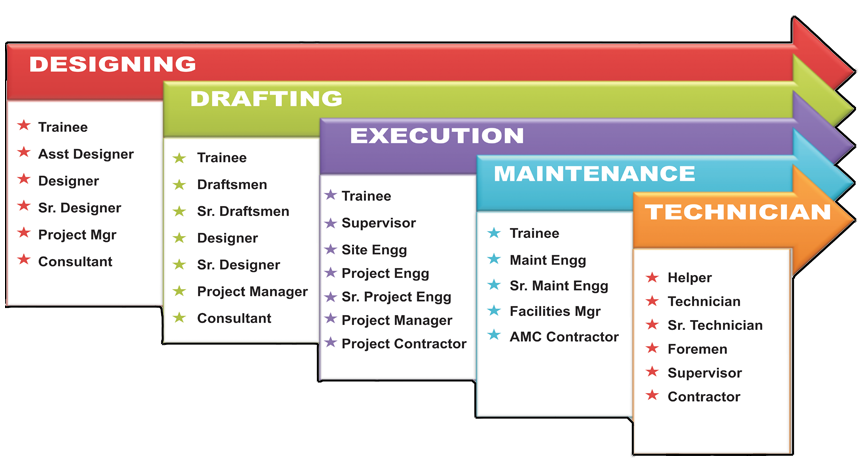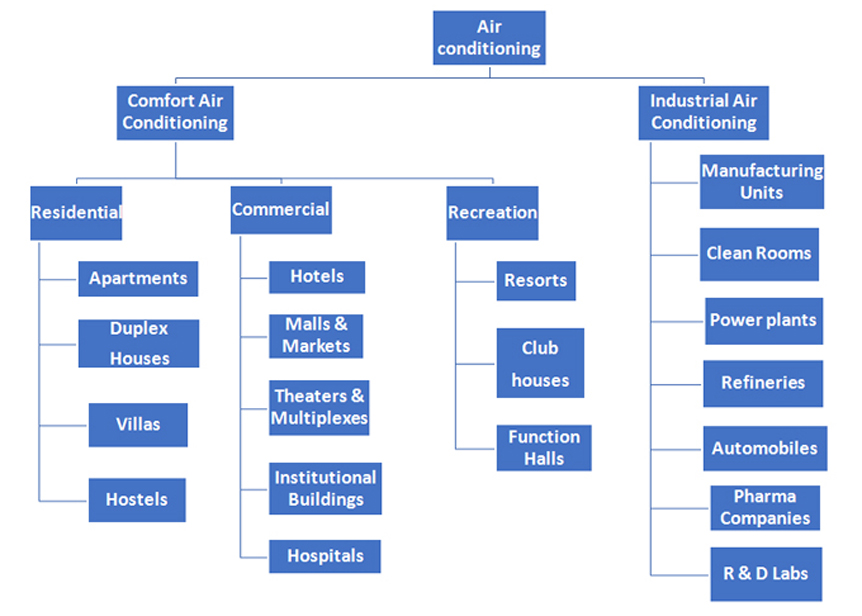HVAC Design and Drafting
An HVAC (Heating, Ventilation, and Air Conditioning) course offers a comprehensive exploration of the principles and practices essential to creating comfortable and efficient indoor environments. Students delve into the fundamentals of thermodynamics, fluid mechanics, and heat transfer, gaining an understanding of how HVAC systems regulate temperature and air quality. The curriculum covers the design and installation of heating and cooling systems, ventilation strategies, and the integration of energy-efficient technologies. Students also learn about refrigeration cycles, psychometrics, and the selection of appropriate HVAC equipment. Practical aspects of troubleshooting, maintenance, and compliance with industry standards are often integrated into the course, ensuring graduates are well-prepared to contribute to the design, installation, and maintenance of HVAC systems in various residential, commercial, and industrial settings.
1.Prelude to HVAC
a. Fundamentals
b. Modes of Heat Transfer
c. Sensible Heat and Latent Heat
d. Codes and Standards
2.Basic Components of Air-Conditioning and Refrigeration machines
a. Basic
Refrigeration System or Vapor Compression Cycle
b. Pressure – Enthalpy Chart
c. Function & Types of Compressor
d. Function & Types of Condenser
e. Function & Types of Expansion Valve
f. Function & Types of Evaporator
g. Accessories used in the System
h. Refrigerant and Brines
3.
Classification of Air-Conditioning System
a. Window A/C
i.Working of Window A/C with Line Diagrams
b. Split
A/C
i.Types of Split A/C
ii.Working of Split A/C with Line Diagrams
c. Ductable Split
A/C
i.Working of Ductable Split A/C with Line Diagrams
d. Variable Refrigerant Volume
(VRV)/Variable Refrigerant Flow (VRF)
e. Ductable Package
A/C
i.Working of Ductable Package A/C with Line Diagrams
ii.Package Roof Top Units
f. Central Plant Chill Water
System
4.
Categories of Air Conditioning
a. All air system
b. All water system
c. Air - water system
d. Direct Refrigerant system
5. Study of Psychometric
Charts
a. Dry Bulb Temperature
b. Wet Bulb Temperature
c. Dew Point Temperature
d. Relative Humidity
e. Humidity Ratio
f.
Processes
i.Heating
ii.Cooling
iii.Cooling and Dehumidification
iv.Heating and Humidification
v.Finding Values Using the Chart
6. Load
Calculation.
a. Survey of Building
b. Cooling Load Steps
c. Finding Temperature difference(?T) (Wall, Glass, Roof , Partition)
d. Finding ‘U’ Factor (Wall, Glass, Roof, Partition)
e. Finding Ventilation requirement for IAQ
f. Load Calculations (Manually using E-20 form)
g. ESHF, ADP & Air Flow Rate(CFM) Calculation
7. Air
Distribution System
a. Duct-Definition &
Terminology
b. Duct Design consideration
c. Duct sizing methods
d. Duct sizing as per Aspect Ratio
e. Finding Duct size using Ductlator
f. Selection of Diffusers and Grilles
g. Gauge selection for Sheet Metal
h. BOQ Preparation for Duct System.
i. Legends and Symbols used in the HVAC Industry
j. Duct Materials and Insulation materials used in HVAC Industry
k. Concept of CAV & VAV
8. Static Pressure
Calculation
a. Selection of Motor HP
b. Selection Fan/Blower RPM
c. Selection Air Handling Units.
9.
Hydronic System
a. Classification of Water
Piping
b. Pipe sizing for chill water system
c. Fittings used in the HVAC Piping System
d. Valves used in the HVAC Piping System
e. Function of Valves
f. Pump Head Calculation
g. Selection of Pumps
10.
VRF/VRV System
a. Selection of VRF/VRV Equipments
b. Indoor unit grouping
c. Copper Pipe Sizing
d. Refnet Pipe Selection
11. Air
Conditioning Concepts
a. District Cooling System
b. Green Building
c. Clean Rooms
12.
Ventilation systems
a. Kitchen ventilation system
b. Car parking ventilation system
c. Toilet Exhaust Ventilation System
13. Fire
Protection (Awareness)
14.
HVAC software’s
a. XL sheet for Load Calculation
b. Carrier Block Load for Load Calculation (HAP)
c. Duct sizer for Duct sizing
d. TroxCADBase for Diffuser & Grilles
e. Pipe sizer for Pipe sizing
f. Psychrometric Software
15.
Improving Employability Skills
a. Resume Writing Skills
b. Interview Skills Empowering
c. Empowering of Interpersonal Relationships
d. Stress Management
e. Positive Attitude Development
f. Self-Motivation
g. Sentence formation
h. Presentation skills
i. Roles & Responsibilities of Design Engineers
Project Work:
• Two live projects have to be completed before getting the Certificate and
Placement Assistance.
HVAC
Course Duration : 45
days
Eligibility
Any Graduation, Diploma

India HVAC market is expected to cross INR 45,000 Cr by 2022. Growing Economy and infrastructure-based developments and increasing tourism are expected to positively influence India HVAC market over the next five years. The expected 100 Smart Cities are also to be considered.
The increase in the financial status of majority of the population is also one of the reasons for the growth of the HVAC Industry
As per the surveys it is estimated that 2/3 of our Country is yet to be built for the needs of 2030.

+91 80965 57573